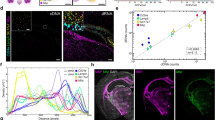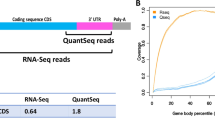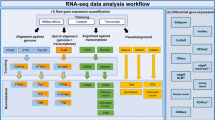Abstract
Quantitative reverse transcription-polymerase chain reaction (qRT-PCR) is a valuable tool for measuring gene expression in biological samples. However, unique challenges are encountered when studies are performed on cells microdissected from tissues derived from animal models or the clinic, including specimen-related issues, variability of RNA template quality and quantity, and normalization. qRT-PCR using small amounts of mRNA derived from dissected cell populations requires adaptation of standard methods to allow meaningful comparisons across sample sets. The protocol described here presents the rationale, technical steps, normalization strategy and data analysis necessary to generate reliable gene expression measurements of transcripts from dissected samples. The entire protocol from tissue microdissection through qRT-PCR analysis requires ∼16 h.
This is a preview of subscription content, access via your institution
Access options
Subscribe to this journal
Receive 12 print issues and online access
$259.00 per year
only $21.58 per issue
Buy this article
- Purchase on Springer Link
- Instant access to full article PDF
Prices may be subject to local taxes which are calculated during checkout






Similar content being viewed by others
References
Best, C.J. et al. Molecular differentiation of high- and moderate-grade human prostate cancer by cDNA microarray analysis. Diagn. Mol. Pathol. 12, 63–70 (2003).
Best, C.J. et al. Molecular alterations in primary prostate cancer after androgen ablation therapy. Clin. Cancer Res. 11, 6823–6834 (2005).
Best, C.J. & Emmert-Buck, M.R. Molecular profiling of tissue samples using laser capture microdissection. Expert Rev. Mol. Diagn. 1, 53–60 (2001).
Richardson, A.M. et al. Global expression analysis of prostate cancer-associated stroma and epithelia. Diagn. Mol. Pathol. 16, 189–197 (2007).
Wiese, A.H. et al. Identification of gene signatures for invasive colorectal tumor cells. Cancer Detect. Prev. 31, 282–295 (2007).
Lee, S. et al. Alterations of gene expression in the development of early hyperplastic precursors of breast cancer. Am. J. Pathol. 171, 252–262 (2007).
Turashvili, G. et al. Novel markers for differentiation of lobular and ductal invasive breast carcinomas by laser microdissection and microarray analysis. BMC Cancer 7, 55 (2007).
Jaeger, J. et al. Gene expression signatures for tumor progression, tumor subtype, and tumor thickness in laser-microdissected melanoma tissues. Clin. Cancer Res. 13, 806–815 (2007).
Sunde, J.S. et al. Expression profiling identifies altered expression of genes that contribute to the inhibition of transforming growth factor-beta signaling in ovarian cancer. Cancer Res. 66, 8404–8412 (2006).
Dahl, E. et al. Molecular profiling of laser-microdissected matched tumor and normal breast tissue identifies karyopherin alpha2 as a potential novel prognostic marker in breast cancer. Clin. Cancer Res. 12, 3950–3960 (2006).
Tsai, M.F. et al. A new tumor suppressor DnaJ-like heat shock protein, HLJ1, and survival of patients with non-small-cell lung carcinoma. J. Natl. Cancer Inst. 98, 825–838 (2006).
Scott, M. et al. Altered patterns of transcription of the septin gene, SEPT9, in ovarian tumorigenesis. Int. J. Cancer 118, 1325–1329 (2006).
Luzzi, V.I., Holtschlag, V. & Watson, M.A. Gene expression profiling of primary tumor cell populations using laser capture microdissection, RNA transcript amplification, and GeneChip microarrays. Methods Mol. Biol. 293, 187–207 (2005).
Yao, F. et al. Microarray analysis of fluoro-gold labeled rat dopamine neurons harvested by laser capture microdissection. J. Neurosci. Methods 143, 95–106 (2005).
Chan, S. et al. The use of laser capture microdissection (LCM) and quantitative polymerase chain reaction to define thyroid hormone receptor expression in human term' placenta. Placenta 25, 758–762 (2004).
Erickson, H.S. et al. Assessment of normalization strategies for quantitative RT-PCR using microdissected tissue samples. Lab. Invest. 87, 951–962 (2007).
Ransohoff, D.F. Lessons from controversy: ovarian cancer screening and serum proteomics. J. Natl. Cancer Inst. 97, 315–319 (2005).
Ransohoff, D.F. Bias as a threat to the validity of cancer molecular-marker research. Nat. Rev. Cancer 5, 142–149 (2005).
Ransohoff, D.F. Rules of evidence for cancer molecular-marker discovery and validation. Nat. Rev. Cancer 4, 309–314 (2004).
Ransohoff, D.F., McNaughton Collins, M. & Fowler, F.J. Why is prostate cancer screening so common when the evidence is so uncertain? A system without negative feedback. Am. J. Med. 113, 663–667 (2002).
Twombly, R. Identity crisis: finding, defining, and integrating biomarkers still a challenge. J. Natl. Cancer Inst. 98, 11–12 (2006).
Compton, C. Getting to personalized cancer medicine: taking out the garbage. Cancer 110, 1641–1643 (2007).
Vaught, J.B. Biorepository and biospecimen science: a new focus for CEBP. Cancer Epidemiol. Biomarkers Prev. 15, 1572–1573 (2006).
Lin, D.W. et al. Influence of surgical manipulation on prostate gene expression: implications for molecular correlates of treatment effects and disease prognosis. J. Clin. Oncol. 24, 3763–3770 (2006).
Micke, P. et al. Biobanking of fresh frozen tissue: RNA is stable in nonfixed surgical specimens. Lab. Invest. 86, 202–211 (2006).
Bova, G.S. et al. Optimal molecular profiling of tissue and tissue components: defining the best processing and microdissection methods for biomedical applications. Mol. Biotechnol. 29, 119–152 (2005).
Gillespie, J.W. et al. Molecular profiling of cancer. Toxicol. Pathol. 32 (Suppl 1): 67–71 (2004).
Ahram, M. et al. Evaluation of ethanol-fixed, paraffin-embedded tissues for proteomic applications. Proteomics 3, 413–421 (2003).
Perlmutter, M.A. et al. Comparison of snap freezing versus ethanol fixation for gene expression profiling of tissue specimens. J. Mol. Diagn. 6, 371–377 (2004).
Leiva, I.M., Emmert-Buck, M.R. & Gillespie, J.W. Handling of clinical tissue specimens for molecular profiling studies. Curr. Issues Mol. Biol. 5, 27 (2003).
Chuaqui, R.F. et al. Post-analysis follow-up and validation of microarray experiments. Nat. Genet. 32 (Suppl): 509–514 (2002).
Gillespie, J.W. et al. Evaluation of non-formalin tissue fixation for molecular profiling studies. Am. J. Pathol. 160, 449–457 (2002).
Emmert-Buck, M.R. et al. Molecular profiling of clinical tissues specimens: feasibility and applications. J. Mol. Diagn. 2, 60–66 (2000).
Ellem, K.A. & Colter, J.S. A consideration of the ribonucleic acid depolymerase-inhibitor systems of mouse tissues. J. Cell. Comp. Physiol. 58, 267–276 (1961).
Erickson, H.S., Gillespie, J.W. & Emmert-Buck, M.R. Tissue microdissection. In Methods Mol. Biol. 424 (ed. Posch, A.) 433–448 (Humana Press, Totowa, NJ, 2008).
Espina, V. et al. Laser-capture microdissection. Nat. Protoc. 1, 586–603 (2006).
Emmert-Buck, M.R. et al. Laser capture microdissection. Science 274, 998–1001 (1996).
Bonner, R.F. et al. Laser capture microdissection: molecular analysis of tissue. Science 278, 1481,1483 (1997).
Okuducu, A.F. et al. Influence of histochemical stains on quantitative gene expression analysis after laser-assisted microdissection. Int. J. Mol. Med. 11, 449–453 (2003).
Rubin, M.A. Tech.Sight. Understanding disease cell by cell. Science 296, 1329–1330 (2002).
Radstrom, P. et al. Pre-PCR processing: strategies to generate PCR-compatible samples. Mol. Biotechnol. 26, 133–146 (2004).
Lefevre, J. et al. Prevalence of selective inhibition of HPV-16 DNA amplification in cervicovaginal lavages. J. Med. Virol. 72, 132–137 (2004).
Sunen, E. et al. Comparison of two methods for the detection of hepatitis A virus in clam samples (Tapes spp.) by reverse transcription-nested PCR. Int. J. Food Microbiol. 91, 147–154 (2004).
Perch-Nielsen, I.R. et al. Removal of PCR inhibitors using dielectrophoresis as a selective filter in a microsystem. Lab Chip 3, 212–216 (2003).
Jiang, J. et al. Development of procedures for direct extraction of Cryptosporidium DNA from water concentrates and for relief of PCR inhibitors. Appl. Environ. Microbiol. 71, 1135–1141 (2005).
Guy, R.A. et al. Real-time PCR for quantification of Giardia and Cryptosporidium in environmental water samples and sewage. Appl. Environ. Microbiol. 69, 5178–5185 (2003).
Bustin, S.A. & Nolan, T. Pitfalls of quantitative real-time reverse-transcription polymerase chain reaction. J. Biomol. Tech. 15, 155–166 (2004).
Nolan, T., Hands, R.E. & Bustin, S.A. Quantification of mRNA using real-time RT-PCR. Nat. Protoc. 1, 1559–1582 (2006).
Morrison, T.B., Weis, J.J. & Wittwer, C.T. Quantification of low-copy transcripts by continuous SYBR Green I monitoring during amplification. Biotechniques 24, 954–958, 960, 962 (1998).
Fleige, S. & Pfaffl, M.W. RNA integrity and the effect on the real-time qRT-PCR performance. Mol. Aspects Med. 27, 126–139 (2006).
Hilscher, C., Vahrson, W. & Dittmer, D.P. Faster quantitative real-time PCR protocols may lose sensitivity and show increased variability. Nucleic Acids Res. 33, e182 (2005).
Stanley, K.K. & Szewczuk, E. Multiplexed tandem PCR: gene profiling from small amounts of RNA using SYBR Green detection. Nucleic Acids Res. 33, e180 (2005).
Suslov, O. & Steindler, D.A. PCR inhibition by reverse transcriptase leads to an overestimation of amplification efficiency. Nucleic Acids Res. 33, e181 (2005).
Stahlberg, A. et al. Properties of the reverse transcription reaction in mRNA quantification. Clin. Chem. 50, 509–515 (2004).
Stahlberg, A., Kubista, M. & Pfaffl, M. Comparison of reverse transcriptases in gene expression analysis. Clin. Chem. 50, 1678–1680 (2004).
Lewis, F. & Maughan, N.J. Extraction of Total RNA from Formalin-Fixed Paraffin-Embedded Tissue (IUL Press, La Jolla, California, 2004).
Lekanne Deprez, R.H. et al. Sensitivity and accuracy of quantitative real-time polymerase chain reaction using SYBR green I depends on cDNA synthesis conditions. Anal. Biochem. 307, 63–69 (2002).
Vandesompele, J., De Paepe, A. & Speleman, F. Elimination of primer-dimer artifacts and genomic coamplification using a two-step SYBR green I real-time RT-PCR. Anal. Biochem. 303, 95–98 (2002).
Simon, R. et al. Design and Analysis of DNA Microarray Investigations (Springer, New York, 2004).
Murphy, R.M. et al. Effects of creatine supplementation on housekeeping genes in human skeletal muscle using real-time RT-PCR. Physiol. Genomics 12, 163–174 (2003).
Khimani, A.H. et al. Housekeeping genes in cancer: normalization of array data. Biotechniques 38, 739–745 (2005).
Warrington, J.A. et al. Comparison of human adult and fetal expression and identification of 535 housekeeping/maintenance genes. Physiol. Genomics 2, 143–147 (2000).
Ross, D.T. et al. Systematic variation in gene expression patterns in human cancer cell lines. Nat. Genet. 24, 227–235 (2000).
Thellin, O. et al. Housekeeping genes as internal standards: use and limits. J. Biotechnol. 75, 291–295 (1999).
Suzuki, T., Higgins, P.J. & Crawford, D.R. Control selection for RNA quantitation. Biotechniques 29, 332–337 (2000).
Bustin, S.A. Absolute quantification of mRNA using real-time reverse transcription polymerase chain reaction assays. J. Mol. Endocrinol. 25, 169–193 (2000).
Aerts, J.L., Gonzales, M.I. & Topalian, S.L. Selection of appropriate control genes to assess expression of tumor antigens using real-time RT-PCR. Biotechniques 36, 84–86, 88, 90–91 (2004).
Biederman, J., Yee, J. & Cortes, P. Validation of internal control genes for gene expression analysis in diabetic glomerulosclerosis. Kidney Int. 66, 2308–2314 (2004).
Tsuji, N. et al. Selection of an internal control gene for quantitation of mRNA in colonic tissues. Anticancer Res. 22, 4173–4178 (2002).
Gorzelniak, K. et al. Validation of endogenous controls for gene expression studies in human adipocytes and preadipocytes. Horm. Metab. Res. 33, 625–627 (2001).
Vandesompele, J. et al. Accurate normalization of real-time quantitative RT-PCR data by geometric averaging of multiple internal control genes. Genome Biol. 3, 34 (2002).
Mamo, S. et al. Quantitative evaluation and selection of reference genes in mouse oocytes and embryos cultured in vivo and in vitro . BMC Dev. Biol. 7, 14 (2007).
Mahoney, D.J. et al. Real-time RT-PCR analysis of housekeeping genes in human skeletal muscle following acute exercise. Physiol. Genomics 18, 226–231 (2004).
Pogue-Geile, K.L. & Greenberger, J.S. Effect of the irradiated microenvironment on the expression and retrotransposition of intracisternal type A particles in hematopoietic cells. Exp. Hematol. 28, 680–689 (2000).
Barnard, G.F. et al. Increased expression of human ribosomal phosphoprotein P0 messenger RNA in hepatocellular carcinoma and colon carcinoma. Cancer Res. 52, 3067–3072 (1992).
Henry, J.L., Coggin, D.L. & King, C.R. High-level expression of the ribosomal protein L19 in human breast tumors that overexpress erbB-2. Cancer Res. 53, 1403–1408 (1993).
Vaarala, M.H. et al. Several genes encoding ribosomal proteins are over-expressed in prostate-cancer cell lines: confirmation of L7a and L37 over-expression in prostate-cancer tissue samples. Int. J. Cancer 78, 27–32 (1998).
Xu, L.L. et al. Quantitative expression profile of PSGR in prostate cancer. Prostate Cancer Prostatic Dis. 9, 56–61 (2006).
Morrison, T. et al. Nanoliter high throughput quantitative PCR. Nucleic Acids Res. 34, e123 (2006).
Fink, L. et al. Real-time quantitative RT-PCR after laser-assisted cell picking. Nat. Med. 4, 1329–1333 (1998).
Tsai, W.J. et al. Real-time PCR quantification using cloned standards and multiple housekeeping genes. Protocol Online. http://www.protocol-online.org/prot/Protocols/Real-Time-PCR-Quantification-Using-Cloned-Standards-and-Multiple-Housekeeping-Genes-3467.html (2009).
Canales, R.D. et al. Evaluation of DNA microarray results with quantitative gene expression platforms. Nat. Biotechnol. 24, 1115–1122 (2006).
Schmid, H. et al. Validation of endogenous controls for gene expression analysis in microdissected human renal biopsies. Kidney Int. 64, 356–360 (2003).
Cohen, C.D. et al. Quantitative gene expression analysis in renal biopsies: a novel protocol for a high-throughput multicenter application. Kidney Int. 61, 133–140 (2002).
Livak, K.J. & Schmittgen, T.D. Analysis of relative gene expression data using real-time quantitative PCR and the 2(-Delta Delta C(T)) Method. Methods 25, 402–408 (2001).
Guidi, C.J. et al. Functional interaction of the retinoblastoma and Ini1/Snf5 tumor suppressors in cell growth and pituitary tumorigenesis. Cancer Res. 66, 8076–8082 (2006).
King, T.A. et al. Heterogenic loss of the wild-type BRCA allele in human breast tumorigenesis. Ann. Surg. Oncol. 14, 2510–2518 (2007).
Acknowledgements
The authors appreciatively thank S. Gonzalez and A. Velasco (The Catholic University, Santiago, Chile) for their collaboration in providing the frozen prostate whole-mount tissue blocks used to assess normalization strategies. R.F.C. and M.R.E.-B. are Federal employee inventors on NIH patents covering LCM and xMD technologies and are entitled to receive royalty payments through the NIH Technology Transfer program. This research was supported by the Intramural Research Program of the NIH, National Cancer Institute, Center for Cancer Research.
Author information
Authors and Affiliations
Corresponding author
Rights and permissions
About this article
Cite this article
Erickson, H., Albert, P., Gillespie, J. et al. Quantitative RT-PCR gene expression analysis of laser microdissected tissue samples. Nat Protoc 4, 902–922 (2009). https://doi.org/10.1038/nprot.2009.61
Published:
Issue Date:
DOI: https://doi.org/10.1038/nprot.2009.61
This article is cited by
-
Transcriptome-based selection and validation of optimal house-keeping genes for skin research in goats (Capra hircus)
BMC Genomics (2020)
-
Identification of reliable reference genes for qRT-PCR in the ephemeral plant Arabidopsis pumila based on full-length transcriptome data
Scientific Reports (2019)
-
Transcriptome profiling of periwinkle infected with Huanglongbing (‘Candidatus Liberibacter asiaticus’)
European Journal of Plant Pathology (2019)
-
An optimised protocol for isolation of RNA from small sections of laser-capture microdissected FFPE tissue amenable for next-generation sequencing
BMC Molecular Biology (2017)
-
Loss of Myosin Vb in colorectal cancer is a strong prognostic factor for disease recurrence
British Journal of Cancer (2017)
Comments
By submitting a comment you agree to abide by our Terms and Community Guidelines. If you find something abusive or that does not comply with our terms or guidelines please flag it as inappropriate.



